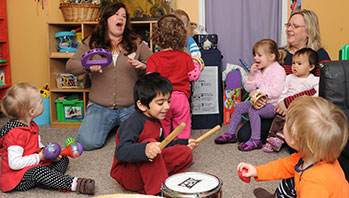MA Standards:
English Language Arts/Speaking and Listening/SL.PK.MA.1a: Observe and use appropriate ways of interacting in a group (e.g., taking turns in talking, listening to peers, waiting to speak until another person is finished talking, asking questions and waiting for an answer, gaining the floor in appropriate ways).
Mathematics/Counting and Cardinality/PK.CC.MA.1: Listen to and say the names of numbers in meaningful contexts.
Head Start Outcomes:
Social Emotional Development/Self-Regulation: Follows simple rules, routines, and directions.
Language Development/Receptive Language: Attends to language during conversations, songs, stories, or other learning experiences.
PreK Learning Guidelines:
English Language Arts/Language 1: Observe and use appropriate ways of interacting in a group (taking turns in talking; listening to peers; waiting until someone is finished; asking questions and waiting for an answer; gaining the floor in appropriate ways).
English Language Arts/Reading and Literature 12: Listen to, recite, sing, and dramatize a variety of age-appropriate literature.
Mathematics/Number Sense 1: Listen to and say the names of numbers in meaningful contexts.
Sing Together: “There Were Ten in the Bed”

© Commonwealth of Massachusetts, Department of Early Education and Care (Jennifer Waddell photographer). All rights reserved.
ELA Focus Skills: Counting, Speaking and Listening, Vocabulary
Ask children to try to visualize ten children crowded together, napping on a bed. Sing the first verse and model the gestures. Then have children sing with you. On the last verse, model how to place your hands so you look like you are sleeping. When you have finished the song, ask, How is this rhyme similar to the book we read, Ten on the Sled?
There Were Ten in the Bed
There were ten in the bed (hold up 10 fingers)
And the little one said, “Roll over! Roll over!” (roll hand over hand)
So they all rolled over and one fell out. (hold up 1 finger)
There were nine in the bed (hold up 9 fingers)
And the little one said, “Roll over! Roll over!” (roll hand over hand)
So they all rolled over and one fell out. (hold up 1 finger)
There were eight in the bed (hold up 8 fingers)
And the little one said, “Roll over! Roll over!” (roll hand over hand)
So they all rolled over and one fell out. (hold up 1 finger)
There were seven in the bed (hold up 7 fingers)
And the little one said, “Roll over! Roll over!” (roll hand over hand)
So they all rolled over and one fell out. (hold up 1 finger)
There were six in the bed (hold up 6 fingers)
And the little one said, “Roll over! Roll over!” (roll hand over hand)
So they all rolled over and one fell out. (hold up 1 finger)
There were five in the bed (hold up 5 fingers)
And the little one said, “Roll over! Roll over!” (roll hand over hand)
So they all rolled over and one fell out. (hold up 1 finger)
There were four in the bed (hold up 4 fingers)
And the little one said, “Roll over! Roll over!” (roll hand over hand)
So they all rolled over and one fell out. (hold up 1 finger)
There were three in the bed (hold up 3 fingers)
And the little one said, “Roll over! Roll over!” (roll hand over hand)
So they all rolled over and one fell out. (hold up 1 finger)
There were two in the bed (hold up 2 fingers)
And the little one said, “Roll over! Roll over!” (roll hand over hand)
So they all rolled over and one fell out. (hold up 1 finger)
There was one in the bed (hold up 1 finger)
And the little one said, “Good night!” (place hands by tilted cheek as if sleeping)
English Language Learners: Tap into the prior knowledge of children who may know similar but unique countdown songs they can share with and teach the group.
Adaptation: With very young children, show the movements to one child at a time.
